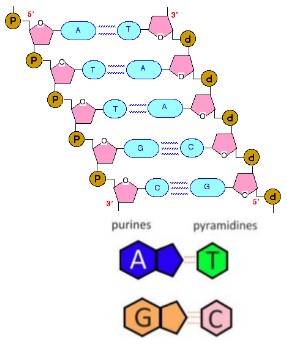Topic : 2 Molecular Biology
2.6 Structure of DNA and RNA
Nucleotides are the building blocks of nucleic acids
- Nucleic acids are one of the major carbon-based groups. There are three major examples of nucleic acids in nature: ATP, DNA and RNA.
- Both DNA and RNA are polymers of nucleotides. Individual nucleotides are referred to as monomers and always consist of three major parts: one phosphate group, one 5-carbon monosaccharide, and a single
nitrogenous base. - All the bonds within the nucleotide involve the sharing of electrons, and are therefore referred to as covalent bonds. The phosphate group is the same in DNA and RNA. However, there are five possible
nitrogenous bases. - DNA nucleotides are made up of 3 components; a phosphate group \((PO_4^{3-})\), a pentose sugar, and a nitrogenous base.
- The phosphate, sugar and base are linked by covalent bonds
- In DNA and RNA each nucleotide is linked to the next nucleotide between the phosphate of one and the pentose sugar of the other nucleotide

Difference between RNA and DNA

Explain how DNA nucleotides form a double helix
- Nucleotides joined by a condensation reaction (between 5’-phosphate & 3’-sugar )
- This forms a sugar-phosphate backbone linked covalently (phosphodiester bonds)
- Two strands run anti-parallel with bases facing inwards (5’→ 3’ versus 3’→ 5’)
- Bases complementarily pair with hydrogen bonds (A pairs with T ; G pairs with C) There are 3 H bonds between G and C; 2 H bonds between T and A.
- This creates a double stranded structure that then twists to form a double helix.
- Guanine and cytosine are held together by 3 hydrogen bonds.
- Adenine and thymine are held together by 2 hydrogen bonds.
- Adenine and Guanine are purines
- Thymine and Cytosine are pyramidines

Crick and Watson’s elucidation of the structure of DNA using model making
- Whist others worked using an experimental basis Crick and Watson used stick-and-ball models to test their ideas on the possible structure of DNA. Building models allowed them to visualize the molecule and see how well it fitted available evidence.
- Their first model, a triple helix, was rejected for several reasons:
The ratio of Adenine to Thymine was not 1:1
It required too much magnesium. - From their setbacks they realize:
DNA must be a double helix;
The relationship between the bases and base pairing;
The strands must be anti-parallel to allow base pairing to happen.
